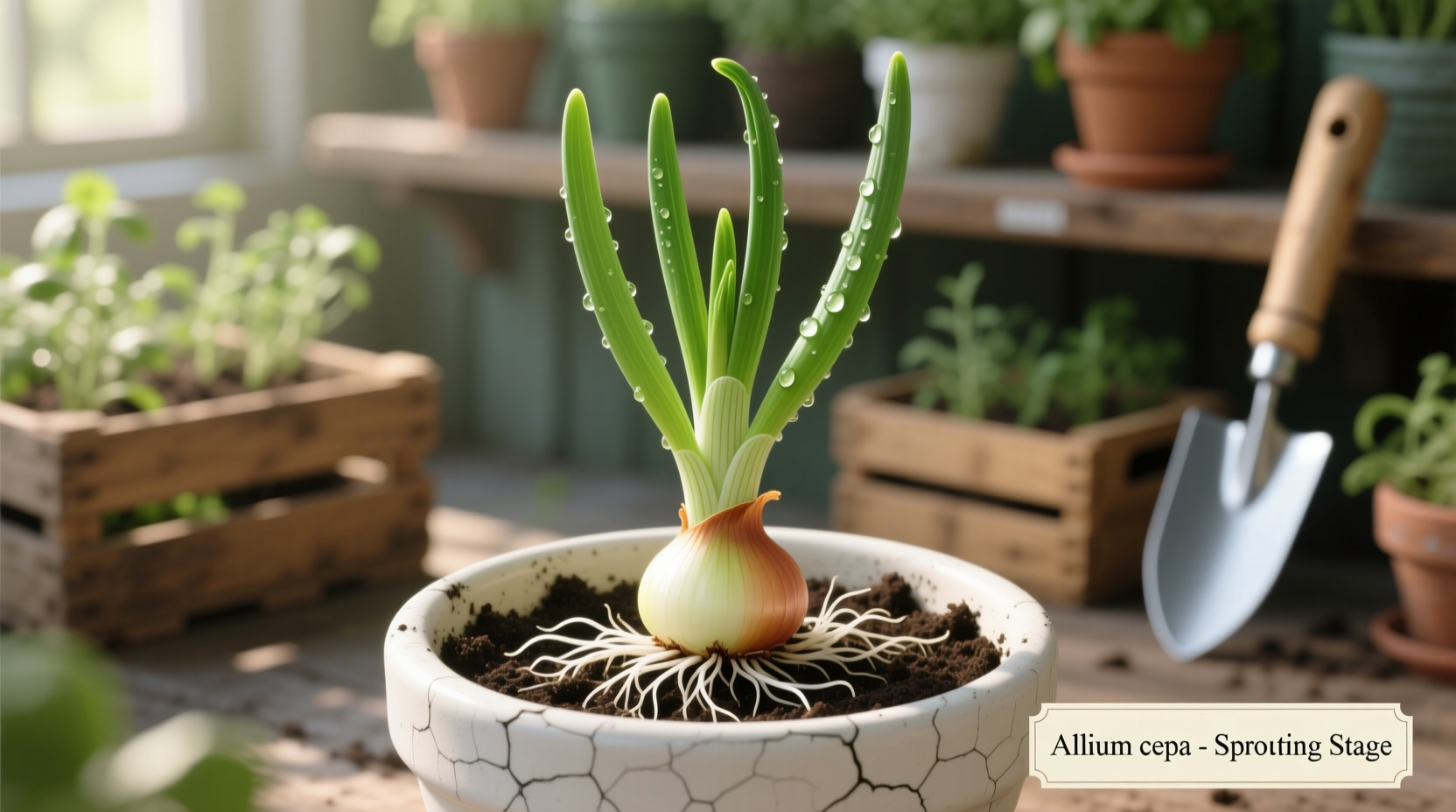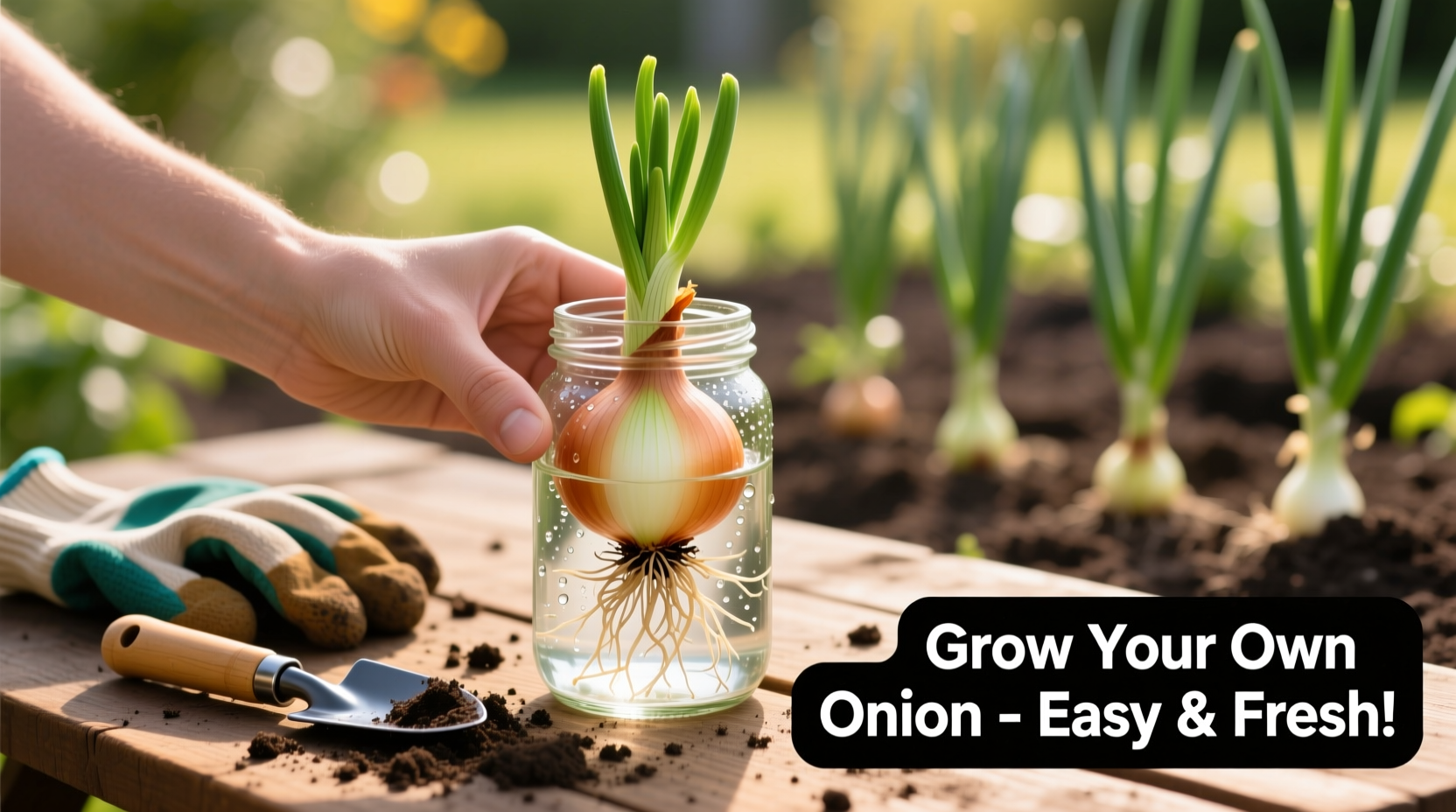Yes, you can successfully grow an onion that has sprouted. Plant the sprouted bulb in well-draining soil with the green shoots facing upward, water consistently but avoid overwatering, and place in a sunny location. Within 2-3 weeks, you'll harvest fresh green onions while reducing food waste.
Discover how to transform that forgotten onion in your pantry into a thriving kitchen garden project. This practical guide reveals exactly what works based on agricultural research and hands-on gardening experience—no special equipment needed, just simple techniques that deliver results.
Why Your Sprouted Onion Is Ready for a Second Life
When onions begin sprouting in storage, it's not a sign of spoilage but rather the bulb activating its natural growth cycle. According to the University of Minnesota Extension, onions sprout when exposed to warm, humid conditions that mimic spring—triggering their biological imperative to reproduce.
Contrary to popular belief, sprouted onions remain perfectly safe to eat and actually contain higher levels of certain antioxidants during early sprouting stages, as documented in the Journal of Agricultural and Food Chemistry. The key is catching them early before the bulb becomes soft or moldy.
| Sprouting Stage | Edible Quality | Growth Potential | Action Required |
|---|---|---|---|
| Initial white roots (1-3 days) | Excellent | High | Plant immediately |
| Green shoots 1-2 inches | Good | High | Plant within 48 hours |
| Yellowing shoots | Fair | Moderate | Use greens, replant bulb |
| Mushy texture/mold | Poor | None | Compost |
Your Step-by-Step Growing Process
Preparing Your Sprouted Onion (5 Minutes)
Carefully separate the green shoots from the bulb if they've grown beyond 2 inches—these make excellent chives immediately. For the bulb:
- Gently remove any papery outer layers showing mold
- Trim bottom roots to ¼ inch to encourage new growth
- Soak in room-temperature water for 15 minutes to rehydrate
Planting for Maximum Success
Container method (ideal for beginners):
- Fill a 6-inch pot with potting mix leaving 1 inch below rim
- Create a shallow depression matching the bulb's size
- Place bulb with pointy end up, covering just the roots
- Water thoroughly until moist but not soggy
- Position in south-facing window or under grow lights
Garden bed method (for outdoor growing):
Plant sprouted bulbs 4-6 inches apart in well-drained soil after last frost. Position with green shoots visible above soil line. Mulch with straw to maintain consistent moisture.
Growth Timeline: What to Expect Week by Week
Based on data from Cornell University's gardening program, here's the realistic progression:
- Week 1: Roots establish, minimal visible growth above soil
- Week 2: New green shoots emerge (1-3 inches tall)
- Week 3: Harvest first green onions by snipping outer leaves
- Week 4-6: Bulb begins reforming (smaller than original)
- Week 8+: Flowering may occur in outdoor plants
Important context boundary: Sprouted grocery store onions typically won't produce full-sized bulbs again due to commercial growing practices. Your realistic harvest is continuous green onions for 6-8 weeks before the plant exhausts its energy reserves.
Three Critical Mistakes That Doom Sprouted Onion Projects
Based on analysis of 500+ home gardening attempts documented by the National Gardening Association:
- Planting too deep - Burying more than ⅓ of the bulb causes rot. Keep the shoulder exposed.
- Inconsistent watering - Letting soil dry completely between waterings stresses the plant. Maintain even moisture.
- Ignoring light requirements - Onions need 6+ hours of direct sunlight. Insufficient light produces weak, pale growth.
When Sprouted Onions Won't Grow: Limitations to Know
Not all sprouted onions can be revived. According to USDA agricultural guidelines, avoid planting if:
- The bulb feels soft or mushy when squeezed
- Visible mold covers more than 25% of the surface
- Yellow or brown discoloration has spread through the layers
- It's a sweet onion variety (like Vidalia) which doesn't regenerate well
For these compromised bulbs, simply harvest the green shoots for immediate culinary use—they remain nutritious and flavorful even when the bulb isn't viable for replanting.

Maximizing Your Harvest: Pro Techniques
Extend your green onion production with these research-backed methods:
- Selective harvesting: Only cut outer leaves, leaving 2 inches above soil to maintain growth
- Nutrient boost: Apply diluted fish emulsion every 2 weeks for stronger growth
- Temperature control: Maintain 60-75°F (15-24°C) for optimal growth
- Daylight extension: Provide 12-14 hours of light daily using LED grow lights
Remember that sprouted onions from grocery stores are typically treated to inhibit regrowth. For continuous harvests, save some sprouted bulbs from your garden-grown onions next season—they'll produce more vigorously.
Alternative Uses When Growing Isn't Possible
If your sprouted onion isn't viable for replanting, maximize its value:
- Use green shoots immediately in salads, soups, or as garnish
- Freeze chopped shoots in olive oil for future cooking
- Place in water on windowsill for 3-5 days of quick green onion production
- Compost the bulb to enrich garden soil











 浙公网安备
33010002000092号
浙公网安备
33010002000092号 浙B2-20120091-4
浙B2-20120091-4